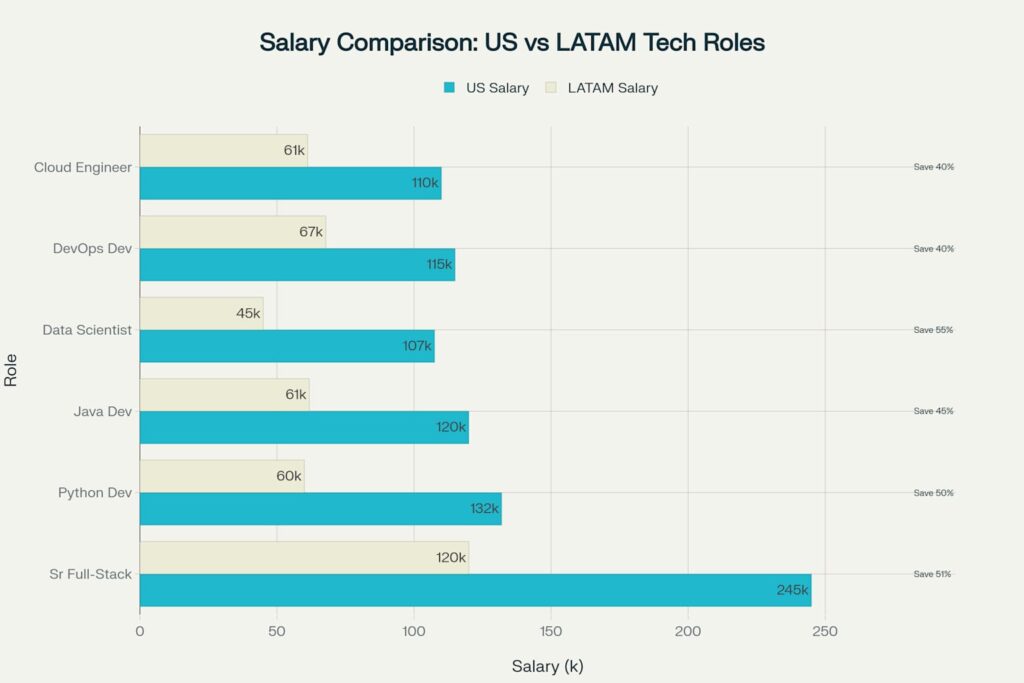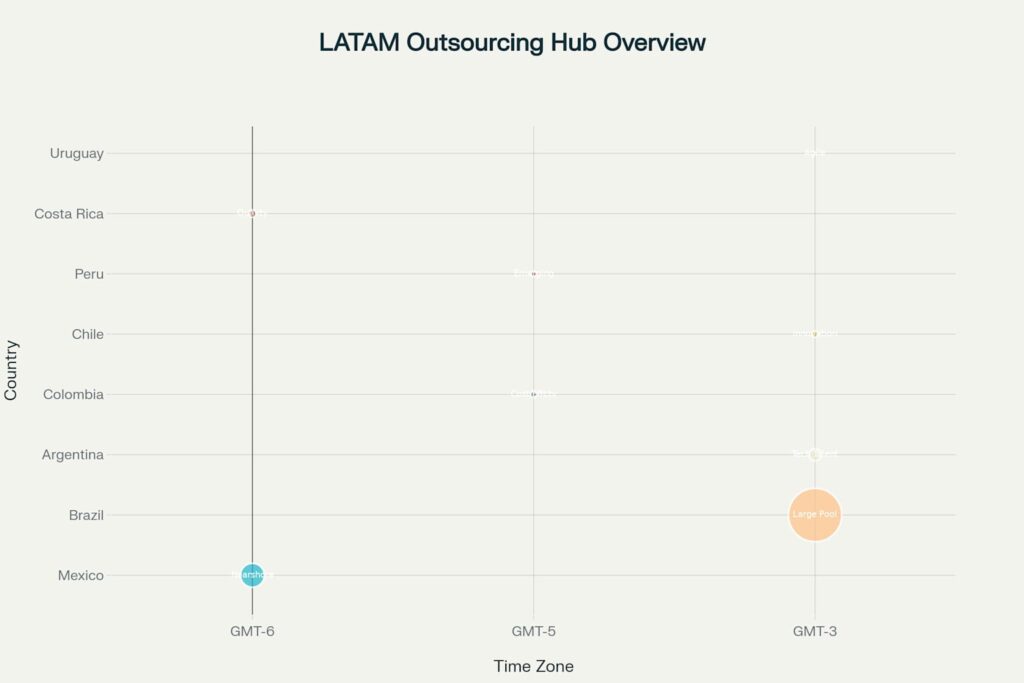The global talent landscape is rapidly evolving, and forward-thinking companies are discovering a remarkable opportunity right in their backyard. Latin America (LATAM) has emerged as the premier destination for outsourcing and staffing solutions, offering an unmatched combination of skilled professionals, cost efficiency, and strategic proximity. As businesses worldwide grapple with talent shortages and escalating costs, LATAM presents a compelling alternative that delivers exceptional value without compromising quality.
The numbers speak volumes: in 2025, the LATAM IT Services market is projected to reach an impressive $59.7 billion, with an annual growth rate of 9.5% that surpasses even Asia’s 9% growth rate. This explosive growth, driven by emerging technologies like artificial intelligence, blockchain, and 5G, positions Latin America as the fastest-growing IT outsourcing destination globally. With over 2 million developers across the region and the potential for 40-70% cost savings compared to North American talent, LATAM represents an unprecedented opportunity for companies seeking to scale efficiently while maintaining world-class standards.
The Economic Imperative: Why LATAM Outsourcing Makes Financial Sense
The financial advantages of partnering with LATAM talent are both immediate and substantial. According to recent industry analysis, companies can achieve significant cost reductions while accessing top-tier expertise. A senior full-stack developer commanding $245,000 annually in the United States can be hired for approximately $120,000 in Latin America—representing a remarkable 51% cost savings without sacrificing quality or capabilities.

This cost efficiency extends across multiple technical disciplines. Python developers earning n. $120,000-$144,000 in the US market are available for $57,600-$62,400 in LATAM, while data scientists can be secured for $42,000-$48,000 compared to their US counterparts earning $95,000-$120,000. These savings enable companies to reinvest resources into research and development, marketing initiatives, and business growth strategies.
The Business Process Outsourcing market in LATAM is equally compelling, with projections indicating growth to $16.59 billion by 2025 and a compound annual growth rate of 3.63% through 2030. This sustained growth reflects the region’s maturity as a reliable outsourcing destination and its increasing sophistication in delivering complex business solutions.
Beyond immediate cost savings, LATAM offers superior value retention. Companies report that remote hiring from Latin America increased by 286% in the second half of 2021, with continued growth of 161% in the first half of 2022. This trend reflects not just cost considerations but also the recognition of LATAM’s exceptional talent quality and cultural compatibility.
Strategic Geographic Advantages: Time Zones and Cultural Alignment
One of LATAM’s most compelling advantages is its strategic geographic position, offering time zone compatibility that enables seamless collaboration with North American teams. Unlike offshore alternatives in Asia or Eastern Europe, LATAM countries operate within 1-4 hours of US time zones, facilitating real-time communication and eliminating the coordination challenges associated with distant outsourcing relationships.

Mexico operates in GMT-6, aligning perfectly with Chicago’s time zone, while Colombia shares GMT-5 with major US business centers including New York, Washington, Florida, and Virginia. Argentina and Chile operate in GMT-3, requiring only minimal schedule adjustments for effective collaboration. This temporal proximity enables companies to maintain standard business hours for critical communications, daily stand-ups, and collaborative project work.
The cultural alignment extends beyond mere time zones. Latin American professionals demonstrate strong familiarity with North American business practices, having worked extensively with US corporations for decades. Major companies like Microsoft, Amazon, and IBM have successfully built teams across LATAM, creating a deep pool of professionals who understand US communication styles, quality standards, and project management methodologies.
Recent surveys indicate that 47% of LATAM workers prefer fully remote work arrangements, while 45% favor hybrid models, demonstrating the region’s adaptability to modern work preferences. This flexibility, combined with lower turnover rates compared to domestic hires, provides companies with stable, committed teams that integrate seamlessly into existing organizational structures.
The Talent Excellence Factor: Skills, Education, and Expertise
LATAM’s talent pool represents a remarkable combination of quantity and quality, with the region producing increasingly sophisticated technical professionals across multiple disciplines. The numbers are impressive: Mexico leads with over 225,000 developers, Brazil boasts 500,000+ technical professionals, while Argentina, Colombia, and Chile each contribute substantial pools of skilled workers.
The educational foundation supporting this talent explosion is equally robust. Brazil alone graduates approximately 125,000 engineers annually, while the broader LATAM region produces 186,200 STEM graduates each year. These professionals emerge from prestigious institutions including Universidad Nacional Autónoma de México, Tecnológico de Monterrey, Universidad de Buenos Aires, and Pontificia Universidad Católica de Chile.
Technical expertise varies by country, with each nation developing particular strengths. Mexico has established itself as the region’s second-largest fintech ecosystem, with developers ranking third regionally for data science proficiency. Colombia excels in JavaScript development, hosting one of Latin America’s largest JavaScript communities while ranking fifth regionally for overall technology skills. Argentina demonstrates exceptional capabilities in mobile development, data analytics, and AI implementation, ranking third in the region for AI policy development.
The quality of LATAM technical talent has gained international recognition. In Coursera’s global tech skill assessments, Latin American professionals consistently score highly across programming languages including .NET, Java, Ruby, Python, C++, C#, React, and Node.js. This technical proficiency, combined with growing English language skills—particularly in Argentina, which ranks first in LATAM for English proficiency—creates an ideal foundation for international collaboration.
Country-Specific Advantages: Choosing the Right LATAM Partner
Each LATAM country offers unique advantages that align with different business needs and strategic objectives. Understanding these distinctions enables companies to select the optimal destination for their specific requirements.
Mexico stands out for its proximity to the United States and sophisticated fintech ecosystem. With over 20 innovation parks and government-led incentives including 500 Startups LATAM and Fondo Nacional Emprendedor, Mexico provides an established infrastructure for technology collaboration. The country’s 225,000+ developers benefit from over 120 technical universities, creating a steady pipeline of qualified professionals.
Brazil represents the region’s largest technology market, with 500,000+ developers and 28 cities ranked as top startup destinations. The country’s massive scale enables companies to find specialized expertise across virtually any technical discipline, while its mature business environment provides stability for long-term partnerships.
Argentina offers the region’s highest English proficiency and exceptional expertise in artificial intelligence and mobile development. Government-led CESSI internships ensure graduates enter the workforce fully prepared for professional responsibilities, while favorable business laws provide tax reductions of up to 75% for tech startups under the Entrepreneurs’ Law.
Colombia has earned recognition as the “Silicon Valley of Latin America,” with Medellín serving as a major technology hub. The country’s 62,000+ developers demonstrate particular strength in JavaScript and web development, while rapidly advancing infrastructure supports sophisticated technical projects.
Chile provides a business-friendly environment with minimal regulatory barriers and 61,000+ well-educated, English-proficient developers. The country’s stability and technical excellence make it ideal for companies seeking reliable, long-term partnerships.
Additional emerging markets including Peru, Costa Rica, and Uruguay offer specialized advantages. Peru’s growing IT market and entrepreneurial Lima startup scene provide access to emerging talent, while Costa Rica’s high-quality infrastructure and tech parks support advanced technical projects. Uruguay, designated as Latin America’s first Digital Nation, offers highly educated professionals focused on building long-term relationships.
Addressing Implementation Challenges: Legal, Cultural, and Operational Considerations
While LATAM outsourcing offers compelling advantages, successful implementation requires careful attention to legal compliance, cultural sensitivity, and operational best practices. The region’s employee-centric business landscape differs significantly from the employment-at-will model common in the United States, emphasizing benefits, job security, and positive workplace cultures.
Legal compliance varies significantly across LATAM countries, with each jurisdiction maintaining distinct labor laws, tax systems, and regulatory requirements. Colombia, for example, mandates specific worker protections including eight-hour daily limits, 48-hour weekly maximums, and 75% overtime premiums. The country requires employer contributions for pensions, healthcare, labor risk pools, family allowances, and various social programs.
Argentina presents a different compliance landscape, with employer contributions totaling approximately 37% of employee salaries to fund retirement schemes, social services, and insurance policies. Employees contribute an additional 17% for pension funds, social security, and health insurance. These requirements, while substantial, reflect the region’s commitment to worker protection and social stability.
Successful LATAM partnerships require cultural sensitivity and understanding of local business practices. Latin American cultures typically emphasize personal relationships and trust-building, which may extend the initial relationship development period but ultimately creates stronger, more committed partnerships. Companies should invest time in understanding local customs, communication styles, and professional expectations.
Risk mitigation strategies include partnering with experienced Employer of Record (EOR) providers who understand local regulations and can ensure compliance. These partnerships eliminate legal complexities while enabling companies to focus on core business objectives. Additionally, implementing comprehensive data security protocols becomes essential, given that global data breach costs average $4.88 million annually.
Technological Innovation and Future Trends
The LATAM outsourcing landscape continues evolving with emerging technologies and changing business requirements. Artificial intelligence and automation are increasingly integrated into outsourcing services, with companies seeking providers who can leverage AI-driven tools for enhanced efficiency and capabilities.
The rise of AI-powered staffing solutions is transforming talent acquisition in the region. Platforms now utilize artificial intelligence for candidate vetting, skills assessment, and cultural fit evaluation, reducing hiring timeframes from months to days. These technological advances enable faster, more accurate talent matching while maintaining high-quality standards.
Robotic Process Automation (RPA) adoption is accelerating across LATAM markets, with organizations implementing automated workflows for data entry, billing, complaint processing, and report generation. This technological integration delivers processing time reductions of up to 80% while eliminating manual errors and reducing costs by 30% compared to traditional models.
The nearshoring trend continues gaining momentum, with 62% of companies exploring nearshoring options to reduce risk and improve speed to market. LATAM’s proximity advantage becomes increasingly valuable as companies prioritize supply chain resilience and operational flexibility. Research indicates that companies implementing nearshoring strategies experience 20% increases in customer satisfaction due to improved response times and communication quality.
Looking toward 2025 and beyond, the global Business Process Outsourcing market is projected to reach $525.23 billion by 2030, with Latin America capturing an increasing share through its combination of talent quality, cost efficiency, and strategic advantages. The region’s continued investment in education, infrastructure, and technology positions it for sustained growth and leadership in the global outsourcing market.
Best Practices for LATAM Outsourcing Success
Maximizing the benefits of LATAM outsourcing requires strategic planning and implementation of proven best practices. Successful companies follow systematic approaches that address technical, cultural, and operational considerations.
Partner Selection and Due Diligence: Choose providers with proven track records, excellent client reviews, and demonstrated expertise in your specific industry or technology requirements. Platforms like Clutch provide valuable insights into provider performance and client satisfaction. Evaluate recruitment speed, replacement rates, and overall efficiency metrics to ensure alignment with your timeline and quality expectations.
Cultural Integration: Invest in understanding local business cultures and communication preferences. Provide cultural orientation for your existing teams and establish clear communication protocols that respect regional preferences. Regular video conferences, collaborative tools, and structured feedback mechanisms help build strong working relationships across geographic boundaries.
Legal and Compliance Management: Work with experienced legal counsel or EOR providers who understand local regulations and can ensure full compliance. Establish clear contract classifications, intellectual property protections, and data security protocols. Regular compliance audits help identify and address potential issues before they become significant problems.
Technology Infrastructure: Implement robust communication and collaboration tools that support real-time interaction across time zones. Invest in secure data transmission systems and establish clear protocols for intellectual property protection. Cloud-based project management platforms enable seamless coordination and progress tracking.
Performance Management: Establish clear metrics, milestones, and quality standards that align with your business objectives. Regular performance reviews, skills assessments, and professional development opportunities help maintain high standards while supporting team member growth.
The Committed Staff AI Advantage
At Committed Staff AI, we understand that successful LATAM outsourcing requires more than just cost savings—it demands strategic partnership, cultural understanding, and unwavering commitment to quality. Our comprehensive approach combines cutting-edge technology with deep regional expertise to deliver exceptional staffing solutions that drive business growth.
Our AI-powered vetting process enables us to maintain LATAM’s most comprehensive talent pool while reducing client hiring time by over 100 hours. Through sophisticated algorithms and human expertise, we match companies with professionals who align perfectly with technical requirements, cultural preferences, and business objectives.
We provide end-to-end support including talent acquisition, legal compliance, payroll management, and ongoing relationship management. Our network spans all major LATAM markets, enabling us to identify the optimal talent pool for your specific needs while ensuring full regulatory compliance in each jurisdiction.
The future of business is global, but success requires local expertise. LATAM represents an unprecedented opportunity for companies seeking to scale efficiently, access world-class talent, and maintain competitive advantages in rapidly evolving markets. With proper planning, strategic partnership, and cultural sensitivity, LATAM outsourcing delivers transformational results that extend far beyond simple cost savings.
As the digital economy continues expanding and remote work becomes increasingly mainstream, Latin America stands ready to power the next generation of business growth. The question isn’t whether to explore LATAM opportunities—it’s how quickly you can begin leveraging this remarkable talent ecosystem to achieve your strategic objectives.
Taking Action: Your Next Steps
The LATAM advantage is clear, but realizing its benefits requires decisive action and strategic implementation. Begin by assessing your current talent needs, identifying skill gaps, and evaluating potential cost savings across different roles and functions. Research specific country advantages that align with your technical requirements and business culture.
Engage with experienced LATAM staffing providers who can guide you through the process while ensuring compliance and quality standards. Start with pilot projects or specific roles to gain experience and build confidence before expanding your LATAM presence.
The global talent revolution is already underway, and Latin America is leading the charge. Companies that embrace this opportunity now will benefit from first-mover advantages, stronger talent relationships, and sustainable competitive positioning. The future belongs to organizations that think globally while acting strategically—and LATAM provides the perfect foundation for both.
Ready to unlock the power of Latin American talent? Contact Committed Staff AI today to discover how our comprehensive staffing solutions can transform your business growth strategy. Our team of experts is standing by to help you navigate the LATAM opportunity and build the world-class team your business deserves.



Recent Comments